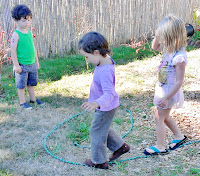 Why Brains?
Why Brains?
We're building on what we started
last week,
the day before,
the day before, and the
day before that.
How Did I Invite Them?
I took some tickets and a sharpie outside. I quietly walked up to the
children who had previously shown interest, and I whispered, "Here's the ticket for the brain group! I'm writing a [pause in case the child wanted to label the letter] yes, a B, and then an [pause] YES! an R! and then an [pause] A! and then [pause] an I! And lastly, a [pause]... hmmm... bbbbrrrrrraaaaayyyyyNNNNNN... Yes! an N!"
How Did I Set Up The Group Area?
I brought air hardening clay, wire, and scissors for the first part and pens and little cardstock pieces for the second part.
What Was My Intention For Today?
I wanted to provide a provocation that would support more story telling and discussions around brains.
What Did We Do?
Me: This clay is a special kind of clay that can harden if we leave it out, and I thought that since we've been thinking about brains so much, we might want to see how we can use this clay to make brains that we can take home. I also brought this wire because we've been talking about the nerves sending messages into our bodies.
M: Do we have to do that?
Me: Nope! You can use the clay and the wires however you'd like.
M: I want to make these like the nerves. They're like, attached to your
brain but not a part of your brain.
Me: And they carry the messages
throughout your body?
M: Yep. Like all the way down to your legs to tell you to jump.
M: And I was going to try to make the brain smooth, but brains are bumpy, so mine's all bumpy.
T: Can I see?
W: Mine is a brain that got sick so
it's getting a shot.
T: Mine too. It needs a shot right here!
W: Hey, that looks CRAZY!
G: Yeah, look, this one is crazy too! This is a brain when it's crazy. [...] And THIS is a brain that can FLY! [...] And this is a brain that's being funny!

At one point, everyone discusses the way that they use the scissors to cut the wire. G tries to use two hands to see if leverage helps make the cut. W convinces M to use the scissors in her right hand with her thumb in the small hole. T finally decides that his wire is actually going to stay as the shot and that it needs to stay long.
W: This is what your brain looks like,
when you put your hands together! [she places her two fists next to
each other.]
T does the same: Like this?
M: Yeah, yeah! Like this! And look
Amy, your brain is bigger than mine!
Me: Hmmm... I wonder what that's about!
M: Well, there's just more room in your head, so you brain can get bigger.
 |
| (Remember G's first B?) |
As the children finish their brains, I offer them a piece of cardstock and a choice of sharpies. "If you're interested, " I say, "you can write the letters for BRAIN on this, and I'll set your brain on it to dry."
As we made our way to the backyard, M exclaims, "I'm using my cerebellum to JUMP!" T decides, "I'm gonna RUN!" G "zoooooms." And W "gallops."
 |
| A very funny brain that can fly. |
 |
| M's intentionally textured brain with nerve attached. |
Reflections
Wow.
These children have so many ideas about how brains work, what brains look like, how brains change depending on what they're feeling, how brains are what send messages to our bodies about movement and emotions, and so on.
They enjoy sharing their ideas, showing each other how they do things, creating games out of their work, and generally being silly.
Ideas for Families
OMSI has all sorts of body exploration possibilities in their
Life Hall.
G talked about brains flying, and W mentioned that fish have itty bitty brains last week, and M observed that a grasshopper probably has a cerebellum because it jumps, and I wonder what conversations would arise when watching the
swifts!
These kids dig art, and the
Portland Art Museum offers free admission to kids under 17 and family tours on Sundays.



































